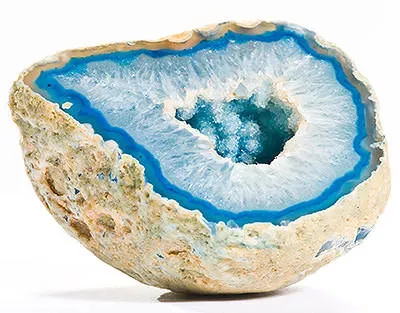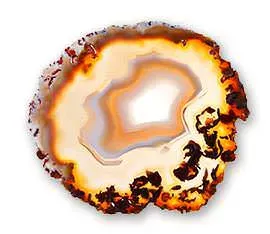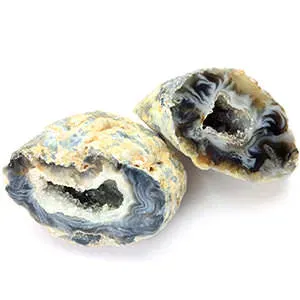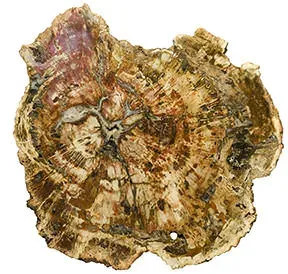 Agate is also known as
Agate is also known as ![]() chalcedony. It is a stone that has been used for centuries as gems and as precious materials for the production of ornaments or small sculptures. The name chalcedony comes from Chalchedon, an ancient port on the Sea of Marmara, in Asia Minor. Ornamental materials used to be mined in that area and it was an active trading center for many gems. Various forms of agate used to be used extensively for bases and handles of gold items such as goblets, and for stone inlay work. Tiny crystals of
chalcedony. It is a stone that has been used for centuries as gems and as precious materials for the production of ornaments or small sculptures. The name chalcedony comes from Chalchedon, an ancient port on the Sea of Marmara, in Asia Minor. Ornamental materials used to be mined in that area and it was an active trading center for many gems. Various forms of agate used to be used extensively for bases and handles of gold items such as goblets, and for stone inlay work. Tiny crystals of ![]() quartz interlock to form agate and because of this, it is always opaque to translucent. Agate is an excellent material for cameos as the contrast between the different layers is used to heighten the relief. Agate's value was quite high in antiquity, when it was one of the main gemstones used. Now its value is fairly low, except for the rare green form called chrysoprase.
quartz interlock to form agate and because of this, it is always opaque to translucent. Agate is an excellent material for cameos as the contrast between the different layers is used to heighten the relief. Agate's value was quite high in antiquity, when it was one of the main gemstones used. Now its value is fairly low, except for the rare green form called chrysoprase.
 Unusual colors and markings of agate made it very highly regarded by the ancients and it was revered throughout history until the present. According to Pliny the Elder, agate was believed to make its wearers "agreeable and persuasive and give them god's favor." In the middle of the 1800's, amulets made from eye agate (brown or black agate with a white ring in the center) were so popular that agate cutters in Germany had no time to cut anything else. The eye was believed to take on the watchfulness of one's guardian spirit and to protect the wearer from the evil eye.
Unusual colors and markings of agate made it very highly regarded by the ancients and it was revered throughout history until the present. According to Pliny the Elder, agate was believed to make its wearers "agreeable and persuasive and give them god's favor." In the middle of the 1800's, amulets made from eye agate (brown or black agate with a white ring in the center) were so popular that agate cutters in Germany had no time to cut anything else. The eye was believed to take on the watchfulness of one's guardian spirit and to protect the wearer from the evil eye.
 Agate rates a 6.5 to 7 on the hardness scale. The typical color of agate is a blue whitish grey. The most highly prized forms of agate are
Agate rates a 6.5 to 7 on the hardness scale. The typical color of agate is a blue whitish grey. The most highly prized forms of agate are ![]() sard, cornelian, chrysoprase and
sard, cornelian, chrysoprase and ![]() jasper. Agate has many subspecies, which are distinguished by their colors and patterns. Carnelian is yellow-orange to orangey red and translucent. Chrysocolla is an intense light blue or blue-green. Chrysoprase is translucent, light to medium yellowish green, and was once considered to be a prized form of
jasper. Agate has many subspecies, which are distinguished by their colors and patterns. Carnelian is yellow-orange to orangey red and translucent. Chrysocolla is an intense light blue or blue-green. Chrysoprase is translucent, light to medium yellowish green, and was once considered to be a prized form of ![]() jade. Bloodstone is another form of agate, opaque and dark green with spots of dark red. Legends said bloodstone was formed out of drops of Christ's blood as he was crucified. Blue Lace Agate is translucent and is lavender to light blue with lacy white lines. Jasper can be different opaque colors, usually green, red, or yellow. Jasper can show various landscape-like patterns within the stone.
jade. Bloodstone is another form of agate, opaque and dark green with spots of dark red. Legends said bloodstone was formed out of drops of Christ's blood as he was crucified. Blue Lace Agate is translucent and is lavender to light blue with lacy white lines. Jasper can be different opaque colors, usually green, red, or yellow. Jasper can show various landscape-like patterns within the stone.
 Moss agate is translucent. It is brown or green with inclusions that look like moss or leaves. Onyx and sardonyx are opaque and banded, or of a solid color. Petrified wood is another form of agate, which is really wood that has been replaced by agate, which follows the wood's structure. Plume agate looks like it is filled with feathers. In general, agate is thought to protect and give courage, help one battle against bad dreams and insomnia, prevent skin ailments and cool fevers. It is also thought to strengthen the spirit, protect from misfortune, give courage to the timid, and banish sadness. In the Middle East, agate was thought to relieve thirst if held in the mouth. Agate occurs in masses, in rocks such as volcanic lavas. It is found in Uruguay, Brazil, Italy, India, China, Mexico, Madagascar, Egypt, Scotland, the US, Canada, and since 1948, in Germany.
Moss agate is translucent. It is brown or green with inclusions that look like moss or leaves. Onyx and sardonyx are opaque and banded, or of a solid color. Petrified wood is another form of agate, which is really wood that has been replaced by agate, which follows the wood's structure. Plume agate looks like it is filled with feathers. In general, agate is thought to protect and give courage, help one battle against bad dreams and insomnia, prevent skin ailments and cool fevers. It is also thought to strengthen the spirit, protect from misfortune, give courage to the timid, and banish sadness. In the Middle East, agate was thought to relieve thirst if held in the mouth. Agate occurs in masses, in rocks such as volcanic lavas. It is found in Uruguay, Brazil, Italy, India, China, Mexico, Madagascar, Egypt, Scotland, the US, Canada, and since 1948, in Germany.